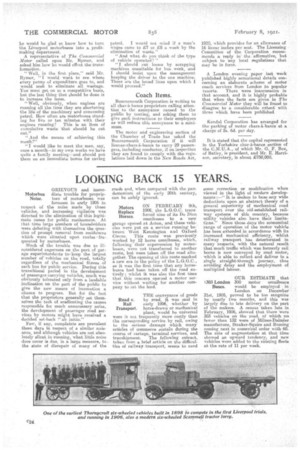LOOKING BACK 15 YEARS.
Page 24

If you've noticed an error in this article please click here to report it so we can fix it.
GRIEVOUS and immeMotorbus diate trouble for proprie
foreseen in early 1906 in respect of the noise made by these vehicles, and increasing vigilance was directed to the elimination of this legitimate cause for public restlessness. At that time large numbers of householders were debating with themselves the question of prompt removal from residences which were situated upon routes • frequented by motorbuses.
Much of the trouble was due to illconsidered eagerness on the part of garage superintendents to keep the largest munber of' vehicles on the road, totally regardless of the mechanical fitneee of each bus for public service. During this transitional period it the development of passenger-carrying vehicles, much was obviously tolerated only from a laudable inclination on the part of the public to give the new means of locomotion a chance to progress. But for the fact that the proprietors generally set themselves the task of eradicating the causes responsible for much unnecessary noise, the development of passenger road services by motors might have received a decided set-back " ab initio."
Few, if any, complaints are prevalent these days in respect of a similar nuisance, and although vaieles are net absolutely silent in running, what little noise does occur is due, M. a large measure, to. the state of disrepair of many of the
roads and, when compared with the pandemonium of the early 20th century, can be safely ignored.
Motors ON FEBRUARY 9th, Re lace 1906, the L.G.O.C. trans ty Horses. furred nine of its De Dion omnibuses to a. new garage opened. at Acton, and these vehicles were put on a service running' between West Kensington aed. Oxford. Circus. This route was previously worked by 12 horse omnibuses, which', following their supersession by motorbuses, were not transferred to another route, but were taken off the road altogether. The opening of this route marked a new era in the policy ef the L,G,O..C,, as it was the-first time that any horsebuees had beers taken off the road entirely; whilst it was also the first time that this concern opined a motor service without waiting for another company to set the lead.
THE conveyance of goods Road v. by read, it was said in Rail early 1905, whether by
transport. horse-drawn or mechanical plant, would be universal were it not frequently more costly than the corresponding service by rail, owing to the serious damage which many articles of commerce sustain during the course of cartage, terminal services, and
transhipment. The following extract, taken from a brief article on the difficulties of railway-transport, seems to need
some correction or modification when viewed in the light of modern developments :—" It is -useless to base any wide deductions upon an abstract theory of a general superiority of mechanical road transport, over the old-established railway systems of this counery, because utility vehicles also have their limitations:" Since those days the oeonomical range of operation of the motor vehicle has been extended in accordance with its increased mechanical efficienty, whilst railway transport has deteriorated in many respects, with the natural result that much traffic which was formerly rail borne is now conveyed by road motor, which is able to collect and deliver in a single straight-through journey, thus avoiding delay and the employment of multiplied labour.
OUR ESTIMATE that 1303 London 300 motor omnibuses Buses. would be employed in
London on December 31st, 1905, proved to be too sanguine by nearly two months, and this was largely due to late delivery on the part of the makers. A census taken late in February, 1906, showed that there were 303 vehicles on the read, of which no fewer than 132 were. a Milnes-Dairaler manufacture, Straker-Squire and Bussing coming next in numerical order with 60. The, rate of augmentation at that time showed an upward tendency, and new vehicles were added to the existing fleets at the rate of 11 per week.






























